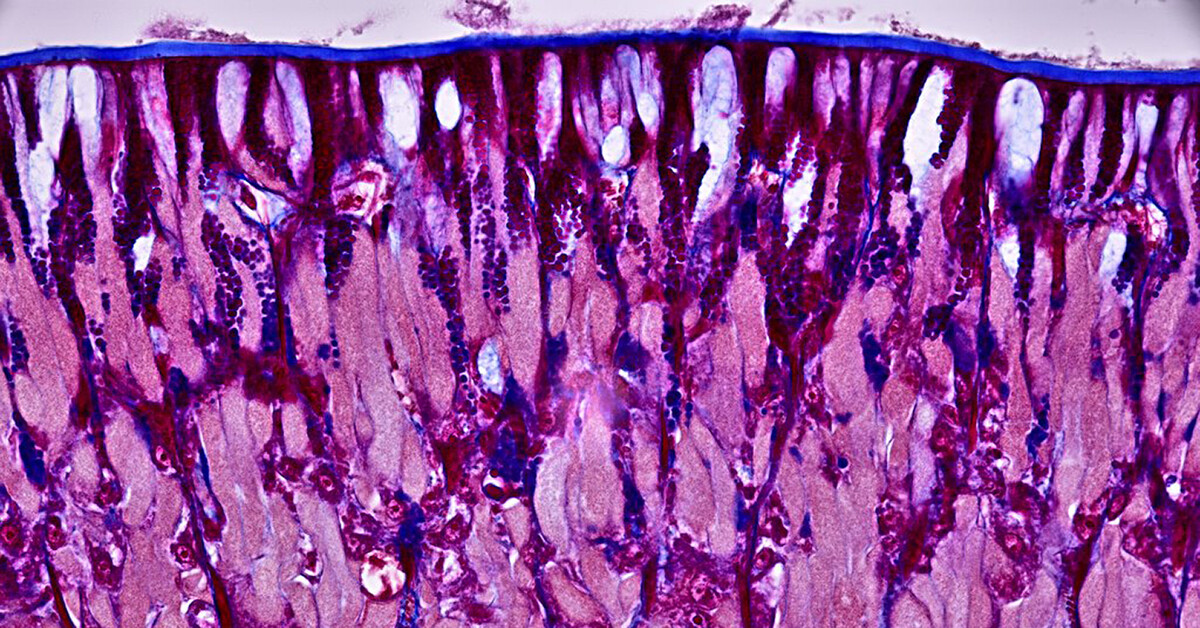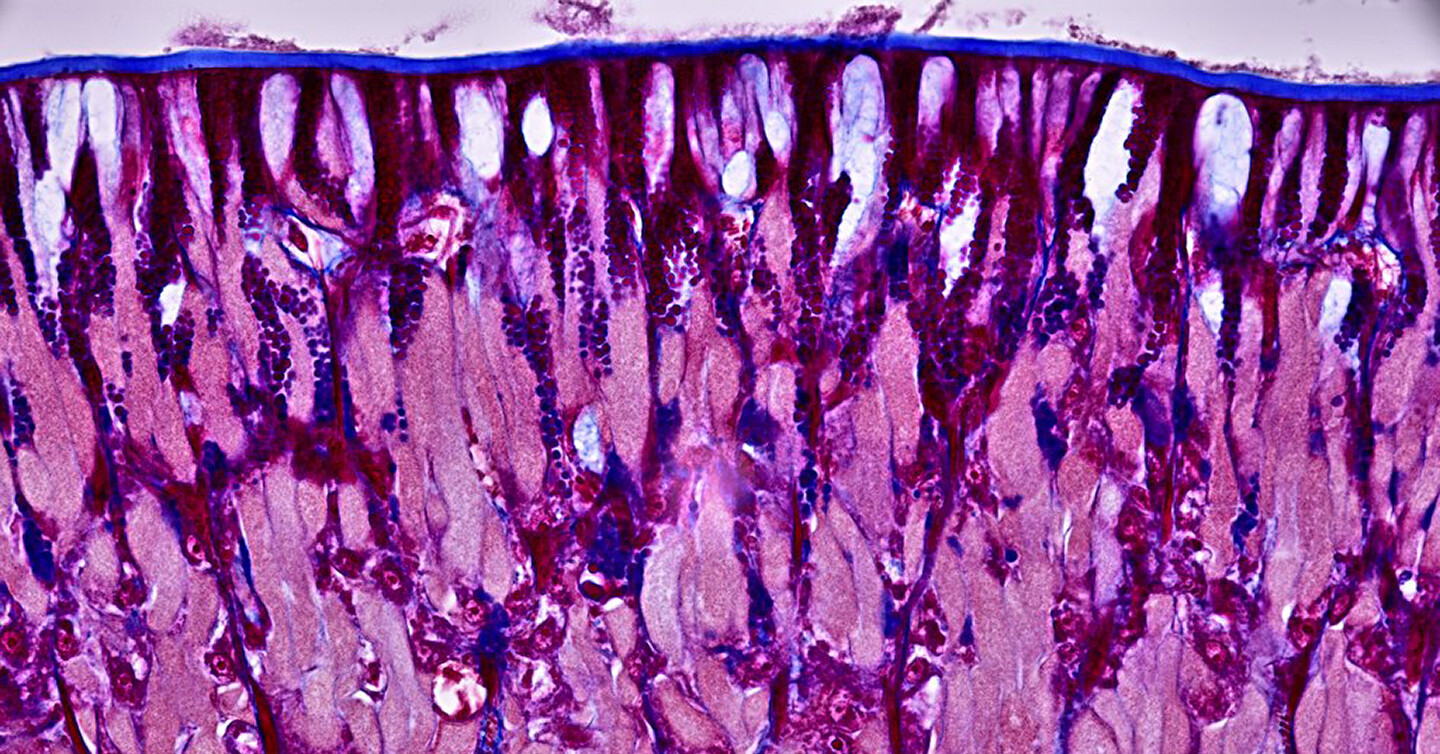You might be slightly irritated when you first dip into the writings of the Russian cosmists. Your irritation could be provoked by the fact that most of the movement’s nineteenth- and early twentieth-century theorists based their futuristic projects on grounds that by now have been thoroughly eroded. The first outdated basis I have in mind is Christianity, with its rigid ethical and gender stances, insistence on divine providence, and linear timeline with an obligatory eschatological end. Two of its logical consequences are an unquestionably anthropocentric viewpoint and a so-called upright posture, which gave human beings imaginary dominion over the planet. Finally, there is cosmism’s universalist sentiment—the idea that all nations must unite to defeat death, gravity, nature, and life itself as it is currently understood—which might force you to postpone looking deeper into the works of the Russian cosmists until happier, spacier times. Because of these qualities, the movement itself can resemble less a rocket ship headed towards interstellar horizons, and more a ponderous and, ultimately, irrelevant episode in the history of Russian philosophy and science. In this sense, the archival approach favored by heavyweight exhibitions dealing with cosmism, such as “Art Without Death: Russian Cosmism” at Haus der Kulturen der Welt in Berlin (September 1–October 3, 2017), could scare you off altogether.
Your irritation might seem justified when, doubled over, you unearth a potentially interesting dusty artifact from a pile of similarly dusty artifacts, unsure that it exists at all. And yet if we remove this pile of junk from the room—that is, remove it from consideration—we shall see the brilliance of what remains in the room and how it can help us understand the present. No longer constrained by a religious ethic and an anthropocentric model of the world, cosmist thinking is ready to be relaunched in an updated set of coordinates.
The cosmists’ own way of thinking facilitates this approach. In reading their essays and books, it’s clear how constrained the cosmists, from Nikolai Fedorov to Alexander Chizhevsky, felt by the concepts on which they based their theories. Cosmist philosophy is sufficiently insane to affirm the idea of the globe as a unity while simultaneously looking for ways to escape its closed bubble. Some cosmists were deeply pious Russian Orthodox believers who preached full equality between man and God, arguing it was the latter’s obligation to create new beings and worlds. Others insisted on the primacy of the human mind in the universe while speculating as to how people could be turned into improved insects in order to better explore outer space. The cosmists did not contradict themselves when they tried to prove the wholly scientific possibility of physical resurrection and human immortality. The cosmists’ own day and age proved too stuffy for their ideas to thrive. They were like fertile pollen, but the pollen was scattered in their own time, not in another time. If we want to follow them, we should not shuffle in time’s wake, but let time follow us.
This means that we should see cosmist discourse as not occurring within time, but running parallel to it, along its own time-space trajectory—a trajectory resembling a spring whose spirals come in different shapes and sizes, rather than a line. Some of the spirals expand and make titanic leaps forward, while others stretch back into the past, sinking their hooks into distant parts of human history and prehistory, such as the time of Adam and the New Testament. Because its parts are so enormously uneven, this cosmist spring must have a rather ugly structure, but it must also be extremely flexible. In order to continuously detect changes and react to them, its spirals are constantly stretched and compressed, expanding and shrinking in all directions. If the cosmists, devoted to their futuristic ideas, were to suddenly find themselves in the present, they perhaps would be the first to apply this springy flexibility to remodel their ideas, adapting them to current intellectual movements. At the same time, the cosmists’ deliberations, balanced on the swaying sides of the spirals, now and then encountered obstacles insurmountable in their own time. In keeping with the spring’s perpetual mobility, we can assume that, after crossing at some point in the 1900s, the sides of the spirals no longer intersect at the same point in 2018. This means that, at the junctures where cosmist thinking was previously halted, we can now take it further without encountering the same obstacles.
Despite the different tendencies within cosmism, we can speak of the entire movement’s main project: the extension of human life, including the attainment of physical immortality, and the idea of using—and even mutating—all the energies of the human body in the service of the conquest of terrestrial and cosmic disasters. Liberating the intellect from the shackles of a still largely animal human nature was to play a key part in achieving this dominion over natural forces. The cosmists argued that man was the only creature on earth endowed with intelligence and the capacity to set and achieve goals, but he was still imprisoned by lust and sexual instinct. Even after standing upright, a posture that made it possible to grab hold of the first tools and look at the sky, man was not freed from the pull of chthonic forces. Moreover, the cosmists posited, our bodies have never fully resigned themselves to this vertical drive. Nikolai Fedorov, one of the principal and earliest proponents of the movement, refers to notes made by the physician Vikenty Veresayev in which the latter claims, “Human organs and their placement have still not adapted to the vertical position, especially among women. Uterine displacement is a quite common ailment. Yet many of these displacements would never have happened if women walked on all fours.” This leads Fedorov to conclude that the process of biological birth was never physically intrinsic to man.1
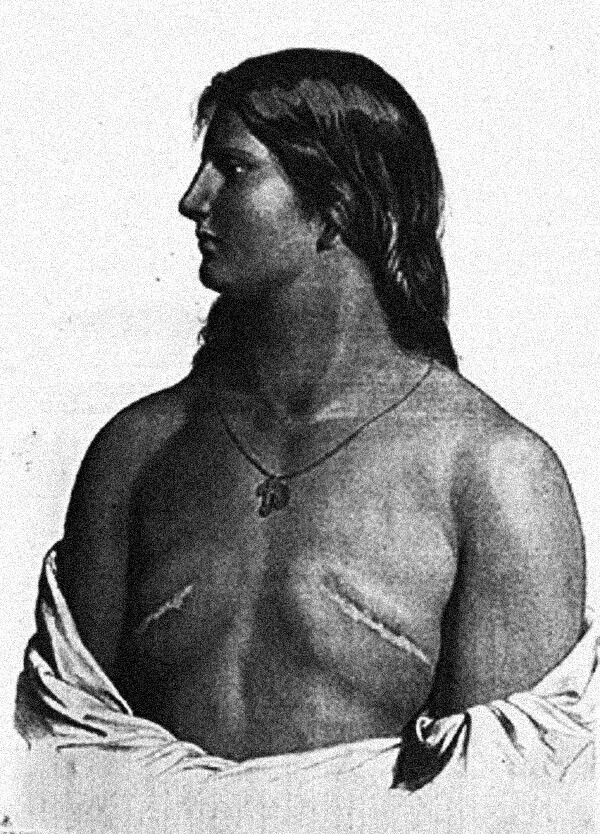

Skoptsy was a heresy sect within the Russian Orthodox Church for in Tsarist Russia. It is best known for practicing castration of men and the mastectomy of women in accordance with their teachings against sexual lust.
Fedorov argues that horizontality is a synonym for everything dead, for death itself, while upwardly directed verticality is a symbol of reason and spirit, of “wakefulness, life, [and] resurrection.”2 Humans can and must acknowledge that their bodies still adhere to completely different goals than their upwardly directed intellect. Women, Fedorov goes on to argue, conceive and give birth to children in a horizontal position. Reproducing this cycle over and over, he says, we further approximate animals. Biological life thus becomes synonymous with death, and the process of conceiving new generations is turned into a bad infinity, a moribund existence.
“Moribund, somnolent, voluptuous life” are the words another proponent of the movement, Vladimir Solovyov, uses to describe man’s natural environment and the creatures populating it. Solovyov feels genuine aversion to mollusks, worms, and other such ideal embodiments of horizontality. Worms, writes Solovyov, “feed with their whole being, the entire surface of their bodies, through endosmosis (absorption), and thus present no organs other than sexual organs. In terms of their strong development and complex structure, the latter provide a striking contrast to the extreme simplicity of the other organs.”3 The worm, covered entirely in mucous tissue, amounts to a sexual organ, driven only by reproduction—a function it performs with tremendous virtuosity. Its ceaselessly sucking, porous, slippery tissue, in contrast with the shell, which protects the absent mind from irritation, is a perfectly constructed membrane designed to engage in the constant interchange of organic compounds within the worm’s habitat.
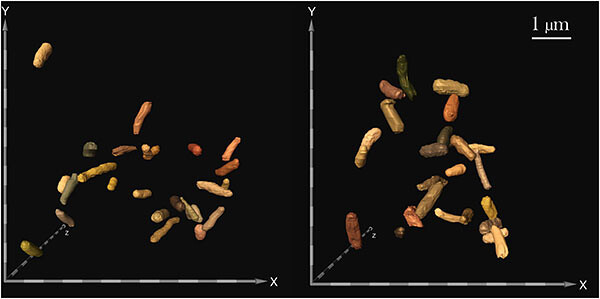

Samples of the bacteria E. Colli dosed with the gentamicin antibiotic, with spaceflight bacteria on the left and Earth control on the right. Image: Zea et al.
Unlike worms, humans have evolved to a state in which the genitals, although capable of influencing thoughts and behavior, are physically concentrated in a specific corporeal location, instead of evenly covering the body with a slippery, vibrating slime endlessly seeking out copulation. For the cosmists, sexual drive was, like death, something to be overcome by the human race. One could argue that a person’s external and internal sexual organs are so self-sufficient and superfluous that they could be completely separated from the body without damaging the latter’s vital functions. There were those in Russia who tested this hypothesis in recent centuries. Through surgical procedures, both male and female members of an eighteenth- through twentieth-century religious movement known as the Skoptsy rid themselves of their external genital organs; women also removed both breasts. Judging by group photos of the castrates, both the women and men acquired facial features distinguished, among other things, by an expressive calm. While evoking the practices of the Skoptsy, the cosmists still could not regard the religious group as sufficient exemplars of their own theories: despite the fact they had completely severed their reproductive instincts, the Skoptsy achieved neither immortality nor perceptible longevity compared with ordinary people. Although they were radical to a certain extent, their practices could not satisfy the requirements of a total victory of immortal mind over body.Fedorovian writer Alexander K. Gorsky argued, along this line of thinking, that the singular location of men’s genitals on the body was a disadvantage. Inspired by Freud’s theories, Gorsky largely adopted the opposite stance in discussions of the female body’s overflowing sexual excess, which Gorsky explained in terms of “the large, moist, mucous-covered area of the [female] genitals,” capable of powerful “emission[s] of energy.”4 Whereas the male genitalia have a definite, clearly distinguishable shape—which means, according to Gorky’s thinking, that we can always speak of their insufficiency—the female genitalia are “deeply hidden inside” women and constantly produce strong “radiations,” indicative of the entire body’s nonstop expansion and outward growth.5 Gorsky imagines this growth as a key factor in mastering one’s own body and, through it, the successful functioning of man on earth and, subsequently, in space. If this energy were radiated not only by organs directly bound up with reproduction, but by the human body’s entire surface, this would make, according to Gorsky, the whole body emerge as an erogenous zone, meaning its hypersensitivity could be freed from serving sexual instinct and directed towards intensive interaction with the world. Thanks to “extra-genital sexuality,” the human body would stop being an insulator, instead becoming a conductor for all kinds of energies and currents. It would become possible to speak of “mucocutaneous and muscular eroticism,” emancipated from sexual instinct.6
According to Gorsky, a new mucous membrane would be photosensitive, restoring the body’s evolutionarily forfeited ability to see with its entire surface. Citing the experience of French writer Jules Romains, Gorsky writes of the possibility of paroptic vision, meaning that thousands of tiny eyes would open all over the human body, while ordinary optical vision would atrophy due to the paucity of its powers. Covered with these rudimentary eyes, the body’s surface would be capable of perceiving and analyzing the environment without the need for rest and sleep. Since “all the skin would become a full-fledged erogenous zone, the erection of the genital organs would spread evenly to all other organs, and they would fulfill (consciously, that is, in coordination with each other) the functions of reproduction [and] the reprocessing … of inorganic matter into organic matter, dead matter into living matter.”7 The impact of external stimuli on the skin and the skin’s instantaneous production not just of nervous and muscular reactions, but of various organic products, would be a vital stage towards the emergence of a new type of human being, capable of “mastering the atmosphere and, perhaps, interplanetary space.”8
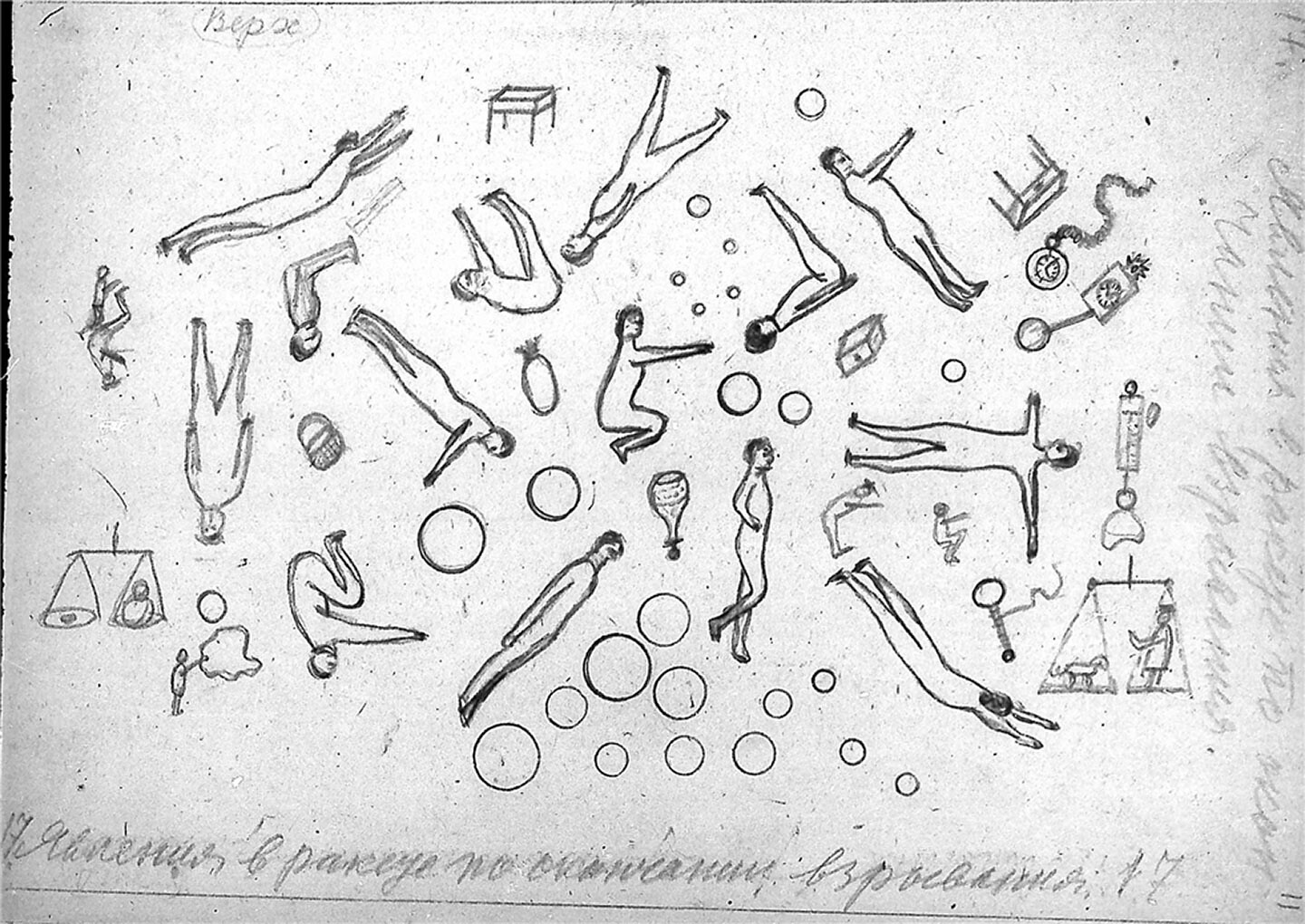

Drawing from Tsiolkovsky’s 1933 paper “Album of Space Travel,” page 11.
Gorsky’s man of the future is a kind of advanced outer-space worm, armed with reason, but also equipped with capacities sloughed off during evolution. Gorsky, who was active in the early twentieth century—that is, half a century later than Fedorov and Solovyov—worked on “turning” the vertical toward the horizontal plane, the realm of worms and all manner of living mucus. Yet the intuition that the border between the living and the dead was permeable, that the vertical and horizontal axes were mutually aligned, had already been voiced by Solovyov. “Organic bodies are mere transformations of inorganic matter, in the exact same … ways that St. Isaac’s Cathedral [in Petersburg] is a transformation of granite, and the Venus de Milo is a transformation of marble.”9 Solovyov hints at the need to inspire the granite and marble with the spirits of their creators, but what matters more in this instance is Solovyov’s paradigm, in which even the religious cosmists found support. Living and dead entities are organically identical, and therefore they are fundamentally and utterly mutually convertible. This opens the way for yet another cosmist insight, so-called organ projection: the cultivation of new, more sophisticated organs on the human body, relying on the functioning of inorganic matter.
Compared with reptiles, birds, and mammals, the human is quite a young species on earth, which means, strictly speaking, that evolution has only begun. This view, shared in one shape or another by all the cosmists, was expressed in specific projects for accelerating human evolution. Whereas Gorsky left his ideas abstract, Pavel Florensky and Konstantin Tsiolkovsky specified concrete steps on the road to bodily transformation. In 1919, Florensky would write about the deep link between the body’s organs and the tools devised by human beings. If tools are extensions of our body parts—just as the first stick, employed towards reasonable ends, was a more efficient extension of the arm—the reverse is also true. The adaptations we have already devised and employed can show us the way to analogously functioning organs in our own bodies. “Tools,” writes Florensky, “are generated by life in its depth, rather than superficial specialization, and each of us in our depths potentially has many different organs that have not been manifested in our bodies, but which could, however, be manifested in technical projections. … Life can technically implement the projection of an organ earlier than we discover it anatomically and physiologically.”10 By studying our machines, we can identify unknown, forgotten, dormant organs inside our bodies, or organs in an embryonic or atrophied state, like Gorsky’s thousands of eyes. Ultimately, this way of thinking finds its apogee in the complete fusion of humans and machines, since to understand the work of the latter most fruitfully, man must learn to think and live like a machine. Gorsky’s worm man is combined with inanimate tools, designed to awaken skills still dormant in the worm.
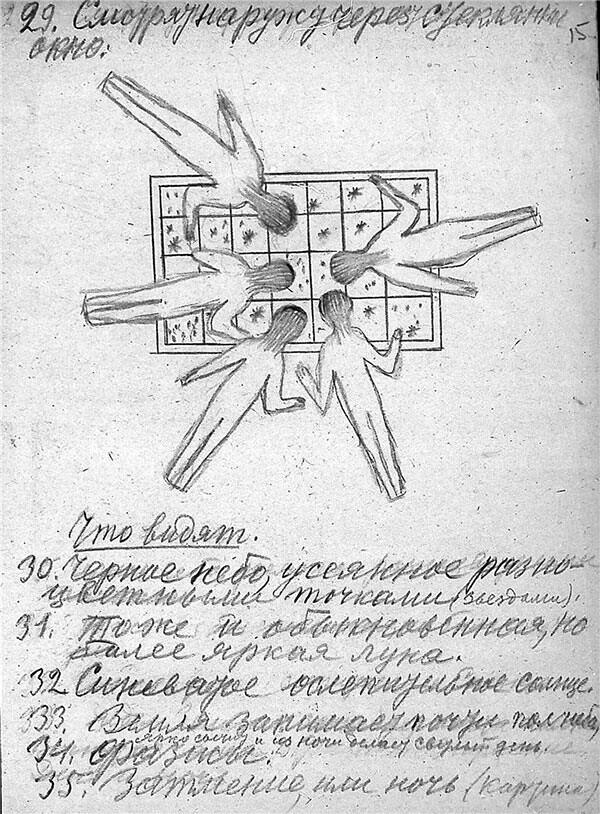

Drawing from Tsiolkovsky’s 1933 manuscript “Album of Space Travel,” page 43.
Finally, another cosmist thinker, Konstantin Tsiolkovsky, who identified himself as a pure materialist, advocated perhaps the most radical changes in the human body. Where Solovyov only gently hints at the permeability of the frontier between the living and the dead, Tsiolkovsky is forthright: “Every particle of the universe is responsive … It is a continuous ladder. It does not end even at the frontier of living matter, because there is no such frontier. It is artificial, like all borders.”11 Tsiolkovsky is extremely pragmatic in his arguments about the bodily transformations necessary for man to conquer outer space. By means of “exercise, selection, crossbreeding, operations, and other methods,” a creature perfectly suited to life on other planets and interplanetary travel could be produced.12 It would be able to subsist on solar energy alone due to its possession of chlorophyll, the pigment that enables plants to process solar energy into nutritious chemical compounds. Waste products would not be released from the body: undergoing the next cycle of processing, these products would further nourish the creature. The creature would be formed from an ovum. As it grew, it would “gradually transform (like a caterpillar into a pupa and butterfly), shedding sweat glands, lungs, [and] digestive organs, and be covered with an impenetrable skin … It would subsist only on the sun’s rays. Its mass would not change, but it would continue to think and live as a mortal or immortal being.”13 In this case, the creature’s body would be designed to facilitate space travel. Its considerable life span, impenetrable shell, and need to feed only on the light of the stars would enable it to travel long distances and render distant planets and galaxies inhabitable.
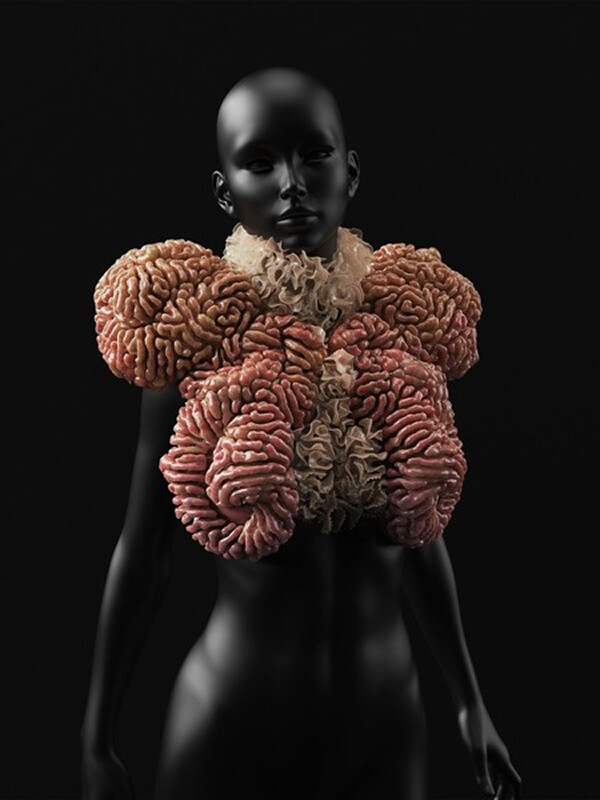

Inspired by the Moon’s surface texture this design by Neri Oxman functions as a wearable pneumatic surface for generating and storing oxygen. Unlike a wearable biodome, this texture contains spatial spherical pockets for algae-based air-purification and biofuel collection.
Tellingly, Tsiolkovsky no longer calls the creature a human being, while, however, endowing it with an intelligence more perfect than human intelligence. Yet he does not fundamentally distinguish between human beings and these improved beings. Tsiolkovsky leaves the matter open. His writings do not make it clear where human beings end and this immortal, self-feeding, armored creature begins. At this point, a difficulty arises that the other cosmists tried to ignore. How can we be sure that the beings they describe will ultimately remain human? We can no longer rely on the religious principle of vertical movement, since the very discourse of Christianity underwent considerable transformations in the twentieth century. The vertical no longer guides us to God, since the very place where God dwells seems to be a separate issue. Nor can we speak of the possession of intelligence and speech as characteristically human. Nowadays, both are human prerogatives, due to our limited knowledge of the world rather than for objective reasons. All that is “truly human” has dissipated in all directions, forcing us to reflect on a global turn of the cross on which the God-man was once crucified.
The cosmist movement had almost completely ceased to exist by the mid-twentieth century, at a time when its radicalism had just begun to gain momentum in Western intellectual culture. For example, Samuel Beckett’s literary characters, who emerged during the period, were meant to shake up principles that were already in a critical condition, and in a certain sense they embodied the premises of the cosmists in the way they behaved. Some of them, resembling blind worms, crawl along the damp, bubbling earth, plugging their whole bodies into a process of intense feeling. Other characters tightly and intricately attach themselves to various tools like bicycles and chairs, literally merging with them. Thanks to this connection, they extend their bodies outward and successfully alter their states of consciousness. Still others have confused the boundaries between living and dying, generating an environment in which life and death have succeeded in permeating each other. Beckett’s posthumanism more than rhymed with the moods of the postwar period, while the cosmist impulse was ultimately doomed to a dramatic false start. This and other factors led to an almost complete neglect of cosmism for many decades. Today, when the concepts voiced by the cosmists do not cause a shock, but rather seem more than timely, the cosmist stamp on these concepts is almost indistinguishable. The idea of the human body’s radical transformation and the barely perceptible doubt of cosmism itself in the humanity of transfigured beings are ubiquitously echoed a hundred years later, while the exceptionally creative nature of the cosmist movement has been intricately twisted in the mirror of a speculative present.
That such a false start occurred probably means that the cosmist spring was stuck on the wrong points on the historical-temporal axis. Hidden simultaneously in the distant past and still vaguely discernible future, the spring lags too far behind the axis of the present. In this sense, the archival nature of exhibitions dealing with cosmism takes on a new dimension in bringing parts of the spring closer to the elusive present. These projects seemingly aspire to slam on the brakes so that cosmism’s body flies ahead and thus catches up with and, perhaps, overtakes the present moment. This slamming always forces the parts of the spring stuck in the past to expand rapidly. If they expand too far, they can snap, generating new spirals and new linkages in our immediate vicinity. At the same time, with the cosmist body’s headlong flight into the here-and-now, the ruptured, severed spiral ends falling on our heads could be fruitful, supplying new viable shoots, coupled with the germs of the speculative present: the spring’s mobility would nicely facilitate hybridization. In the end, only a hybrid, constantly mutating cosmist project can maintain its momentum. The cosmist worm with a thousand eyes shall finally emerge from the soil to catch a sunbeam and reflect it off its shiny skin.
N. F. Fedorov, “Gorizontal’noe polozhenie i vertikal’noe” (The horizontal position and the vertical), in Sochineniia (Works) (Mysl’, 1982), 516.
Ibid., 520.
V. S. Solov’ev, “Krasota v prirode” (Beauty in nature), in Sochineniia v 2 t. (Works in two volumes), vol. 2 (Mysl’, 1990), 378–79.
A. K. Gorskii, “Ogromnyi ocherk” (Large essay), in Sochineniia (Works) (Raritet, 1995) 212.
Ibid., 222.
Ibid., 238.
Ibid., 259.
Ibid., 259.
Solov’ev, “Krasota v prirode,” 371.
P. A. Florenskii, “Organoproektsiia” (Organ projection), in Russkii kosmizm: antologiia filososkoi mysli (Russian cosmism: an anthology of philosophical thought), eds. S. G. Semenova and A. G. Gacheva (Pedagogika-Press, 1993), 161.
K. E. Tsiolkovskii, “Monizm Vselennoi” (The monism of the universe), in Russkii kosmizm, 265.
K. E. Tsiolkovskii, “Zhivye sushchestva v kosmose” (Living beings in space), in Put’ k zvezdam (The way to the stars) (Izdatel’stvo Akademii nauk SSSR, 1960), 302.
Ibid., 306.
Category
Subject
Translated from the Russian by Thomas Campbell. Drawings by Konstantin Tsiolkovsky.
